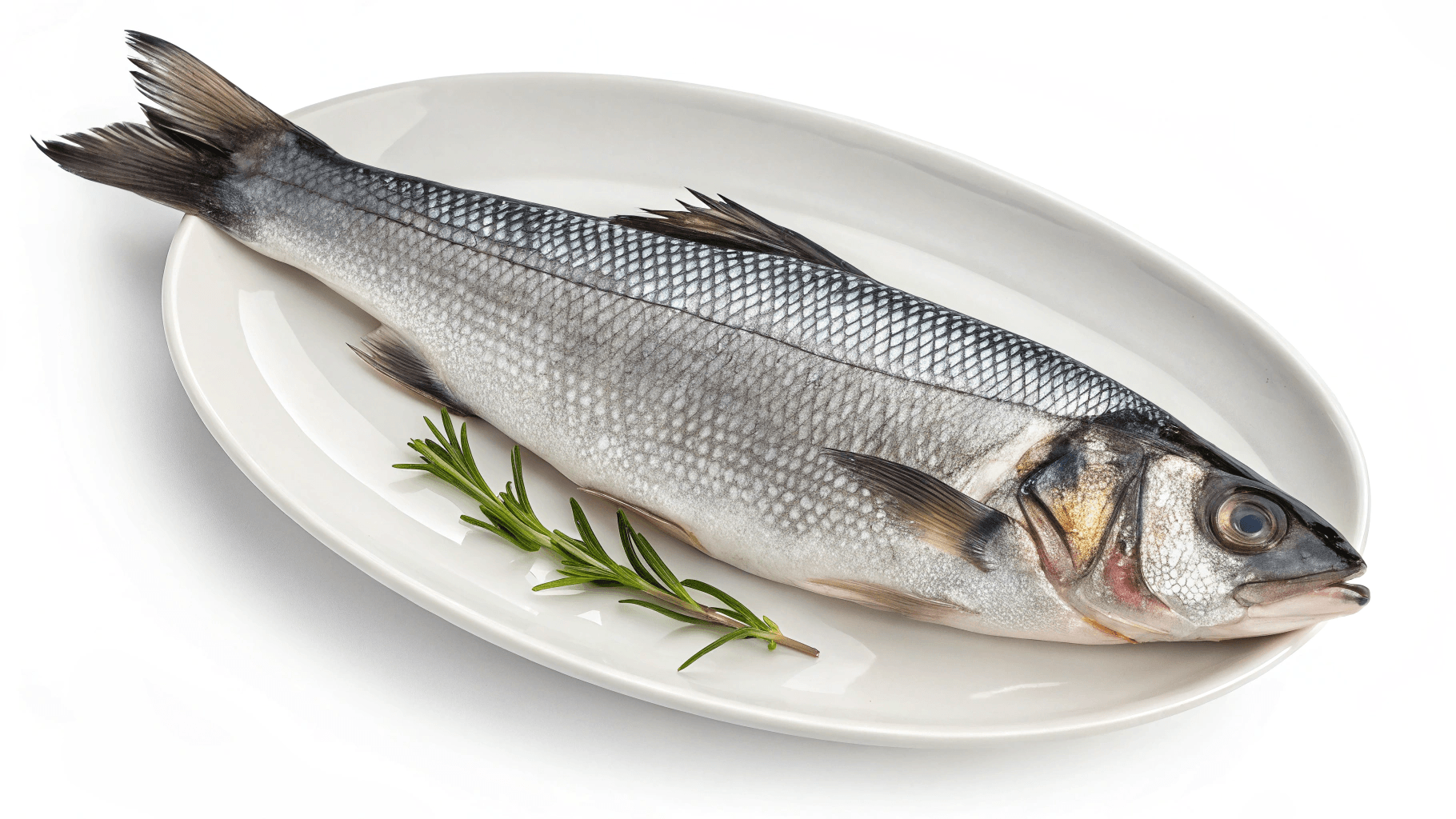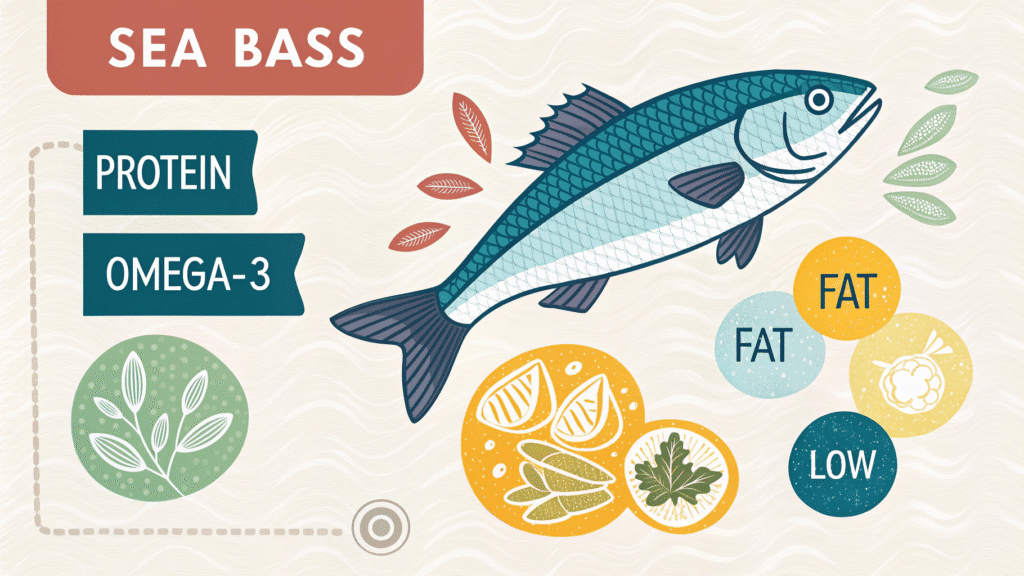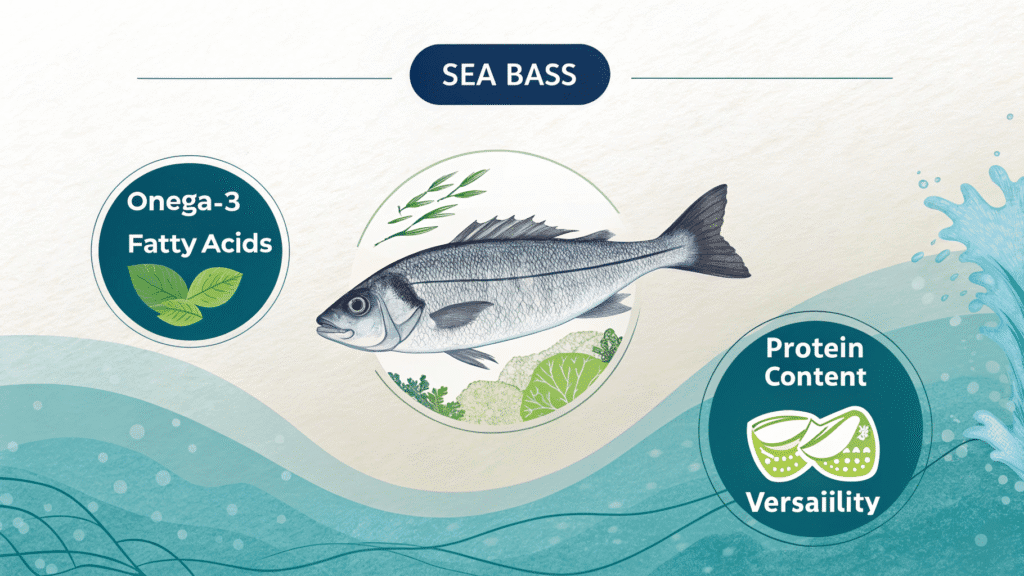Sea Bass Nutrition Info highlights the many health benefits of this fish from the Moronidae family, also known as the “sea wolf” in the Mediterranean. Sea bass is rich in protein, low in fat, and is considered a “lean” fish—making it an excellent choice for a healthy diet.

Sea Bass Nutrition Info: Bar characteristics
-Low in calories;
-Excellent source of protein—maintains lean body mass;
-Excellent source of vitamin B12;
-Rich in phosphorus;
-Source of vitamin D—immune system;
-Source of selenium—antioxidant properties;
-Source of iodine.
Sea bass: nutritional values and calories
Sea bass is virtually fat-free and therefore very low in calories. However, it is very rich in micronutrients that are essential for the body to function properly.
Based on the Ciqual database of average nutrient content.
Per 100g of sea bass:
| Nutrients | Average content |
| Calories (in kcal) | 82.5 |
| Water (in g) | 78.1 |
| Protein (in g) | 19.1 |
| Carbohydrates (in g) | traces |
| Fat (in g) | 0.7 |
| Iron (in mg) | 0.26 |
| Phosphorus (in mg) | 207 |
| Iodine (in micrograms) | 21.9 |
| Selenium (in micrograms) | 30 |
| Zinc (in mg) | 1.3 |
| Vitamin D (in micrograms) | 5.59 |
| Vitamin B12 (in micrograms) | 3.12 |
The benefits of sea bass :
Like most lean fish, sea bass is rich in protein and contains significant amounts of minerals and trace elements.

Protein to maintain muscle mass
With 19.1 g of protein per 100 g, sea bass is an excellent source of protein, and what’s more, it is high-quality protein, as it contains all the amino acids essential for the body to function properly.
Proteins help maintain muscle mass, synthesize protein hormones such as insulin, and produce immunoglobulins.
Source of vitamin D for immunity
Vitamin D has various roles:
-The first is to enable better absorption and fixation of calcium in the skeleton;
-It also plays a part in the body’s defense mechanisms. 30% of the vitamin D we need is provided by our diet. A 100 g serving of sea bass covers a third of our daily vitamin D requirements.
Iodine for thyroid function
Bar is a good source of iodine.
Iodine is essential for proper thyroid function. The main sources are:
-Fish;
-Crustaceans;
-Mollusks;
-Seaweed;
-Iodized salt (consumption of which should be limited) A 100 g serving of sea bass provides 21.9 micrograms, or 15% of the daily requirement.
Rich in vitamin B12
Sea bass is an excellent source of vitamin B12, with a 100 g serving providing 80% of the daily requirement. Vitamin B12 plays a role in nervous system function and red blood cell synthesis.
Source of phosphorus
Sea bass is a good source of phosphorus. This mineral is involved in many physiological mechanisms, including bone and tooth mineralization. One serving of sea bass covers 40% of your daily requirement.
Selenium and antioxidant function
A 100 g serving of sea bass covers 50% of your daily selenium needs. This trace element is involved in thyroid function and the antioxidant process.
A word from the nutritionist
The PNNS (National Nutrition and Health Plan) recommends eating one serving of lean fish per week. Sea bass is therefore an ideal addition to a balanced and varied diet.
Sea Bass Nutrition Info: How to choose the right sea bass?
Sea bass is a fish measuring 25 to 40 cm (size regulated according to fishing areas) with a streamlined body, gray back, and white belly. It is important to distinguish between common sea bass and spotted sea bass.
Food ID card
– Family: Moronidae;
– Origin: North Atlantic, North Sea, English Channel, Bay of Biscay;
-Season: depending on fishing areas and authorized fishing periods;
-Color: gray back, white belly;
-Flavor: delicate and tasty flesh.
At the fishmonger’s
You can tell if fish is fresh by the shiny skin of the sea bass; red eyes and gills are additional signs of freshness.
Wild or farmed sea bass
There are two types of sea bass available for sale, depending on the fishing method and farming method.
Wild sea bass is tastier but also more expensive than farmed sea bass.
Storing sea bass
Sea bass should be refrigerated and consumed quickly, as there is a significant health risk. Sea bass can also be frozen.

How to prepare sea bass in the kitchen?
Sea bass is a semi-fatty fish with tender, flavorful flesh. It is often eaten cooked, but can also be eaten raw in ceviche or carpaccio.
En papillote
Sea bass can be eaten en papillote accompanied by small seasonal vegetables.
In the oven or on the barbecue
The most well-known recipe for sea bass is, of course, sea bass baked in the oven with fennel or garnished with dill, or grilled on the barbecue sprinkled with herbes de Provence.
Contraindications and allergies to sea bass
Like all fish, sea bass presents a risk of allergies. As the health risk is significant, pregnant women are advised not to eat it raw.
History and anecdotes
Sea bass is also known as “loup” in the Mediterranean, a name it owes to its voracious appetite. It is fond of many species of fish such as sardines, anchovies, and sprats.
Ecology and environment
In 2015, the European Commission warned of declining sea bass stocks. It therefore increased the minimum marketing size from 42 cm in the North Sea, English Channel, Celtic Sea, and Irish Sea.
In 2020, France increased the minimum catch size from 38 to 40 cm in the Bay of Biscay and Iberian waters. However, it remains set at 25 cm in the Mediterranean.



